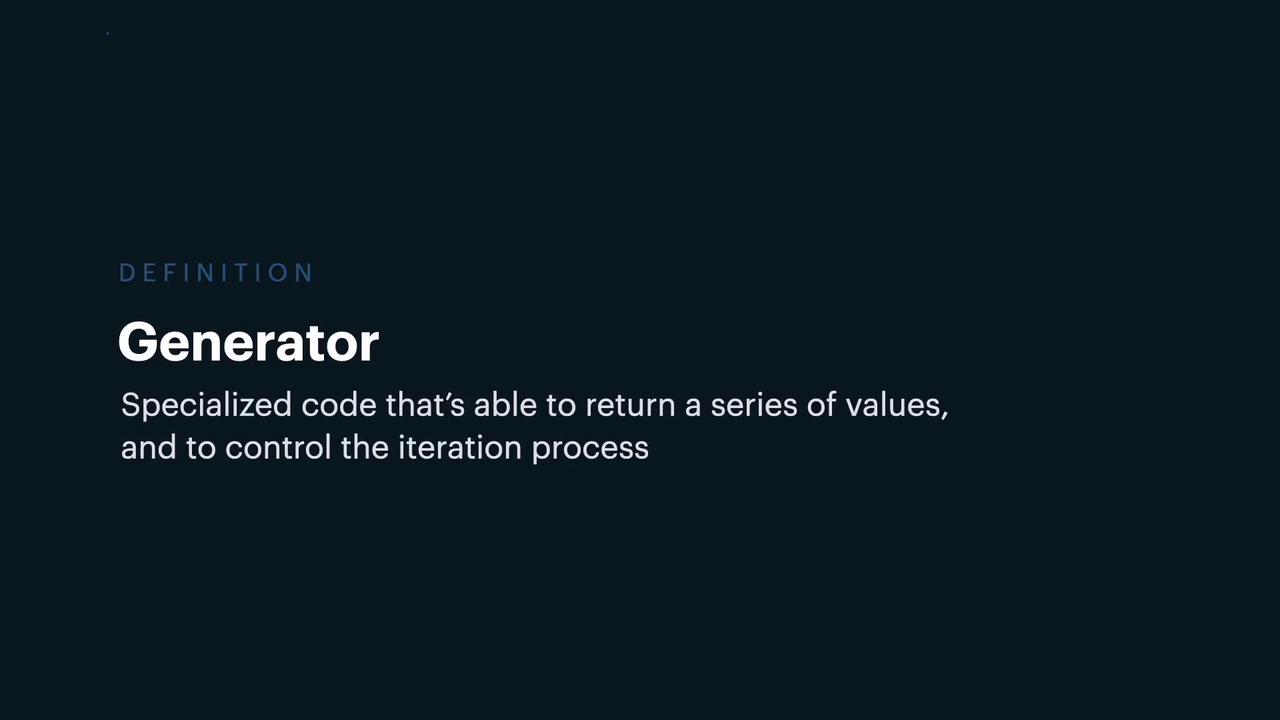PCAP - Python Certification Course
Miscellaneous
Generators List Comprehension Lambda and Closures
In this article, we delve into several core Python concepts: generators, list comprehensions, lambda functions, and closures. By understanding these concepts, you'll be better equipped to write efficient and concise code. We'll start with the range function, which is frequently used to print a sequence of values.
The range function returns an iterator—a special type of generator that produces numbers on demand. Consider the following example:
for i in range(5):
print(i)
Output:
0
1
2
3
4
A generator is a specialized piece of code that can yield a series of values while preserving its state between iterations. Since the range function returns an iterator, it can be used directly within a for-in loop to traverse its values.

Iterators and the Iterator Protocol
An iterator is an object that adheres to the iterator protocol by implementing two core methods: __iter__() and __next__(). The __iter__() method returns the iterator object itself (typically called once), while the __next__() method yields the next value in the sequence. When the sequence is exhausted, __next__() raises a StopIteration exception.

Creating a Custom Generator via an Iterator
Although Python's built-in range function offers a ready-made iterator, you can also create a custom iterator by defining the necessary methods. The following example demonstrates how to implement a custom range class that emulates the behavior of the built-in range:
class CustomRange:
def __init__(self, maximum):
self.__maximum = maximum
self.__current = 0
def __iter__(self):
return self
def __next__(self):
if self.__current >= self.__maximum:
raise StopIteration
result = self.__current
self.__current += 1
return result
custom_range = CustomRange(10)
for i in custom_range:
print(i)
In this implementation, the __iter__() method returns the object itself, while the __next__() method returns the current value before incrementing it. Once the current value reaches the maximum, a StopIteration is raised to signal the end of the iteration.
Tip
Managing state manually in iterators (like keeping track of the current value) can be avoided by using the yield keyword, which simplifies generator creation.
Using Generators with the yield Keyword
The yield keyword allows a function to produce a series of values without losing its state, effectively pausing and resuming the function's execution. Consider this simple example:
def simple_generator():
for i in range(5):
yield i
# Using the generator
for value in simple_generator():
print(value)
Output:
0
1
2
3
4
List Comprehensions and Generator Expressions
List comprehensions provide an elegant and compact method to create lists. Take a look at this example that generates a list of powers of 10 using a traditional for loop:
first_list = []
for x in range(5):
first_list.append(10 ** x)
print(first_list)
Output:
[1, 10, 100, 1000, 10000]
The same result can be achieved more concisely with a list comprehension:
second_list = [10 ** x for x in range(10)]
print(second_list)
Output:
[1, 10, 100, 1000, 10000, 100000, 1000000, 10000000, 100000000, 1000000000]
You can also incorporate conditional expressions within list comprehensions. For example, to create a list that contains 1 for even numbers and 0 for odd numbers:
even_odd_list = [1 if x % 2 == 0 else 0 for x in range(5)]
print(even_odd_list)
Output:
[1, 0, 1, 0, 1]
Generator expressions, similar to list comprehensions, use parentheses instead of square brackets. They generate a generator that can be iterated over when needed, offering an even more memory-efficient approach.
Lambda Functions
Lambda functions (or anonymous functions) allow you to write small functions in a concise way. They are often used alongside functions like map and filter. Here's a simple lambda function to compute the square of a number:
sqr = lambda x: x * x
print(sqr(2))
Output:
4
Lambda functions can also be defined with no arguments or multiple arguments:
# Lambda that always returns 10
lambda: 10
# Lambda that adds two numbers
lambda a, b: a + b
Using Lambda with Map and Filter
The map function applies a specified function to every item of an iterable, returning a new iterator with the results. For example, the following code doubles each number in the list using a lambda function:
nums = [1, 2, 3]
nums_multiplied = list(map(lambda x: x * 2, nums))
print(nums_multiplied)
Output:
[2, 4, 6]
Similarly, the filter function constructs a new iterator comprising only the items that satisfy a specific condition. Consider this example that filters even and odd numbers from a list:
nums = [1, 2, 3, 4, 5, 6, 7]
nums_even = list(filter(lambda x: x % 2 == 0, nums))
nums_odd = list(filter(lambda x: x % 2 != 0, nums))
print(nums_even)
print(nums_odd)
Output:
[2, 4, 6]
[1, 3, 5, 7]
Closures
Closures in Python allow a function to capture and retain access to variables from its enclosing scope, even when the outer function has finished executing. The following example demonstrates a closure:
def outer_fun(x):
def inner_fun(y):
return x * y
return inner_fun
# Create a closure with x bound to 4
var_one = outer_fun(4)
print(var_one(3))
Output:
12
In this case, calling outer_fun(4) returns the inner_fun function, which retains the value of x (equal to 4) in its scope. When var_one(3) is invoked, it multiplies 4 by 3, resulting in 12, even though the execution context of outer_fun has ended.
Important
Closures empower you to write more modular and dynamic code by allowing functions to remember and access data from their defining environment, which is particularly effective in functional programming.
Summary
In this article, we covered:
- How the range function returns an iterator and its similarity to generators.
- The iterator protocol and its core methods:
__iter__()and__next__(). - Creating custom iterators and the advantages of using the yield keyword.
- The benefits and syntactic simplicity of list comprehensions and generator expressions.
- The use of lambda functions, and how to apply them with map and filter.
- The concept of closures and their practical applications in maintaining state.
Start practicing these concepts today to enhance your Python programming skills and develop more efficient, readable code.
Watch Video
Watch video content
Practice Lab
Practice lab